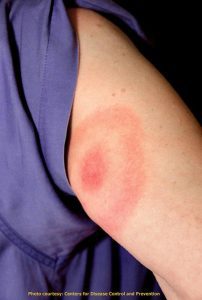Tick-borne illnesses have been on a steady rise in New Jersey over the past two decades. In 2017, there were 3,629 confirmed cases of Lyme disease according to data from the Centers for Disease Control and Prevention. With tick-borne illnesses on the rise, it is important to understand the implications of leaving Lyme disease untreated.
Lyme disease in the United States is caused by a bacterium called Borrelia burgdorferi, and can be transmitted to humans from the saliva of an infected tick. The most common type of tick to carry the infection in New Jersey is the deer tick, also known as the black-legged tick. If left untreated, Lyme disease can affect the central nervous system, heart, and joints, causing complications. However, it can usually be successfully treated by taking antibiotics for approximately 21 days.
Lyme disease is broken down into early symptoms and later symptoms.
Early Symptoms
Early signs of Lyme disease occur 3 to 30 days after initial transmission. The symptoms of early Lyme disease are
- Fever
- Chills
- Headache
- Flu-like symptoms
- Fatigue
- Erythema Migrans (EM) rash, a bullseye shaped rash that usually starts at the site of the bite
The prognosis is excellent if the infection is treated early. Premier Health Associates is open 7 days a week, so if you think you may have been infected, be sure to schedule an appointment with your healthcare provider.
Later Symptoms
If left untreated, symptoms may spread to other parts of the body in the following weeks or months since initial transmission. The later symptoms of Lyme disease are
- Neck stiffness
- Additional EM rashes on other parts of the body
- Facial palsy
- Heart palpitations
- Joint pain
- Problems with short-term memory
- Nerve pain
- Arthritis with swelling
Laboratory blood tests are helpful to properly diagnose a patient with Lyme disease in order to start proper treatment.
Avoidance
The best way to prevent getting Lyme disease is to be vigilant in avoiding bites. Avoid walking through grassy, wooded areas, especially in the spring and early summer. If you must be in these areas, always check yourself for ticks afterwards. Some important places to check for ticks are
- In the hair
- In and around ears
- Inside the belly button
- Under the arms
- Between the legs
- Behind the knees
- Around the waist
Using EPA-registered insect repellents containing DEET can aid in keeping ticks off of your body and clothing. Wearing light-colored clothing can be useful to spot ticks.
It is also important to check your pets regularly for ticks, as Lyme disease can affect them as well. Contact your veterinarian to find the best tick-repellent for your pet.
Finally, it is important to stay vigilant against ticks. Even if you have been infected by a tick bite before, you cannot build an immunity to Lyme disease. Always stay on top of tick-borne illness prevention in order to avoid transmission.
For more facts and information on Lyme disease, please see the CDC information page for Lyme Disease.

